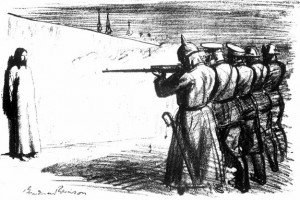I have been waiting to review one of my favorite movies from 2012 for quite some time, Cabin in the Woods. As soon as I saw it I knew I needed to blog about it, and more importantly, I knew I needed to review it this week—Holy week.
Perhaps you’re thinking, this is totally random; why is he reviewing a movie from last year during a time when he should be reflecting on things like Lent, Palm Sunday, the Passover, the Exodus, Good Friday, Easter, and the Resurrection! If you’re thinking this and you’ve seen the movie please keep reading, but chances are you haven’t seen the movie if this is your knee-jerk reaction. If that is the case, please do not read further UNLESS you promise me that you’ll never ever see the movie. Otherwise everything will be ruined and the movie will not be nearly as enjoyable. So now’s your chance. Please exit out of this page and never look at this post again until you see the movie. For all others: you’ve been warned.
***SPOILERS GALORE AHEAD***
What is obvious about Cabin in the Woods is that it is subversive. Although a celebration of the horror genre, it is simultaneously a critique. By all appearances this movie is simply another generic horror flick. It’s called Cabin in the Woods for goodness sake—how bland can you get! But this is all set-up for the subversive nature of the movie. Several common horror-movie tropes are exploited and given a (playful) rationale so as to explain and excuse some of the silliest of all tropes—such as, the over-sexualized blonde girl, the arrogant jock, the “virgin”, the creepy gas-station with even creepier clerk, the GPS not working, and phrases like, “let’s split up.” This is what makes Cabin in the Woods so much fun for those who enjoy the Horror genre and especially the classics like The Evil Dead franchise, to which Cabin in the Woods is a clear hommage with its replica Cabin (PS at this point I should direct those of you who find the genre questionable to an earlier post of mine).
But whereas the subversion of the horror genre is commonly noted and appreciated among fans of the movie, there is still yet another level of subversion on display in the film; the subversion of various notions of “atonement”.
This is why I’ve been waiting to review this movie for Holy Week.
Within the mythology of Cabin in the Woods we are led to believe that all horror movies are actually real life rituals intended to appease the “gods.” Thus, this movie is a reflection on the notion of sacrifice from start to finish. The opening credits begin with blood flowing across a black backdrop, which contain ritualistic scenes of sacrifice. And it goes without saying that the images depict primitive sacrifices. When Mordecai – the creepy gas station clerk known as “the harbinger” – calls the control room he says, “the lambs have passed through the gate… they are the gods’ fools.” And when each of the characters die, a lever is pulled which causes sacrificial blood to fill the outline of one of the archetypal figures that each victim represents in the larger ritual. After Jewels dies, Sitterson, one of the control room administrators, prays, “this we offer in humility and fear, for the blessed peace of your eternal slumber, as it ever was.” And of course at the very end of the movie we get an explanation from the Director herself (played by Sigourney Weaver): “It’s our task to placate the ancient ones, as it’s yours to be offered unto them.”
What all of this amounts to is essentially a critique of organized religion. The control room, with all their light-hearted gambling and orchestration, are the detached priests and pastors of this “religion.” In fact, the control room administrators even reflect on their role in this regard at one point. After Dana kills one of the zombified freaks, Hadley says to Sitterson, “remember when you could just throw a girl in a volcano,” to which Sitterson replies, “how old do you think I am?” This subtle interaction shows the analogy between primitive attempts to appease the gods made by priests of yesteryear, with their current organized system.
The subversion of religion and various atonement theologies can also be seen in the response of Dana and Marty in the final scene. In the face of the wrathful gods, these characters adopt a nihilistic stance, light up a few cigarettes, and say a few jokes; ultimately leading to the destruction of the entire planet.
But this is what seals the deal for me: Cabin in the Woods came out April 13, 2012. That is, it didn’t come out in October, when all the horror movies typically come out, but it came out the week after Good Friday (April 6, 2012) and Easter (April 8, 2012), and the day before Passover ended (April 14, 2012). When the sacrificial imagery in the movie is recognized as subversive of concepts of atonement, as I’ve attempted to show, the timing of Cabin‘s release can hardly be viewed as unintentional.
This means that the filmmakers wanted viewers to walk into the theaters with the grand narratives of atonement fresh in their minds—the Passover and the atonement theology inherent within it as well as the death of Jesus on the cross. It is in that context that the movie finds its ultimate subversion.
But this critique is nothing new. Many people find the notion of atonement too messy, distasteful, and primitive. Some have called the Christian atonement “cosmic child-abuse.” There are many within the church who believe that cultic references to Jesus’ death as “propitiation” (ἱλαστήριον; ἱλασμός) — which means appeasing God’s wrath — should be dismissed in favor of terms like “expiation,” which cut out the notion of wrath.
Though many want to reject propitiation and its connotations, I cannot follow suit. The wrath of God against sin has been appeased—this is good news! Maybe as you’re reading this you’re thinking, But isn’t God a God of love? Why are we talking about wrath just now? Jesus came as a demonstration of God’s love, not to appease his wrath! To be fair, there is a biblical logic to this. 1 John 4.8 declares that God is love, and 4.9 declares that God sent his Son to demonstrate that love. But in fact, the next verse demonstrates the false dichotomy inherent in separating the love of God and the wrath of God when we talk about the atonement: “In this is love, not that we have loved God but that he loved us and sent his Son to be the propitiation for our sins” (1 John 4.10 ESV). This is surely a beautiful mystery. I love the way John Piper puts it, “The wisdom of God has ordained a way for the love of God to deliver us from the wrath of God without compromising the justice of God.” Praise God that, unlike the capricious gods from Cabin in the Woods, our loving and gracious God appeased his own wrath, and we don’t have to ritually offer up sacrifices, let alone human ones! So to close, I simply want to echo the words of the author to the Hebrews (9.13-14 ESV): “For if the blood of goats and bulls, and the sprinkling of defiled persons with the ashes of a heifer, sanctify the purification of the flesh, how much more will the blood of Christ, who through the eternal Spirit offered himself without blemish to God, purify our conscience from dead works to serve the living God.”





9 Comments
Leave your reply.